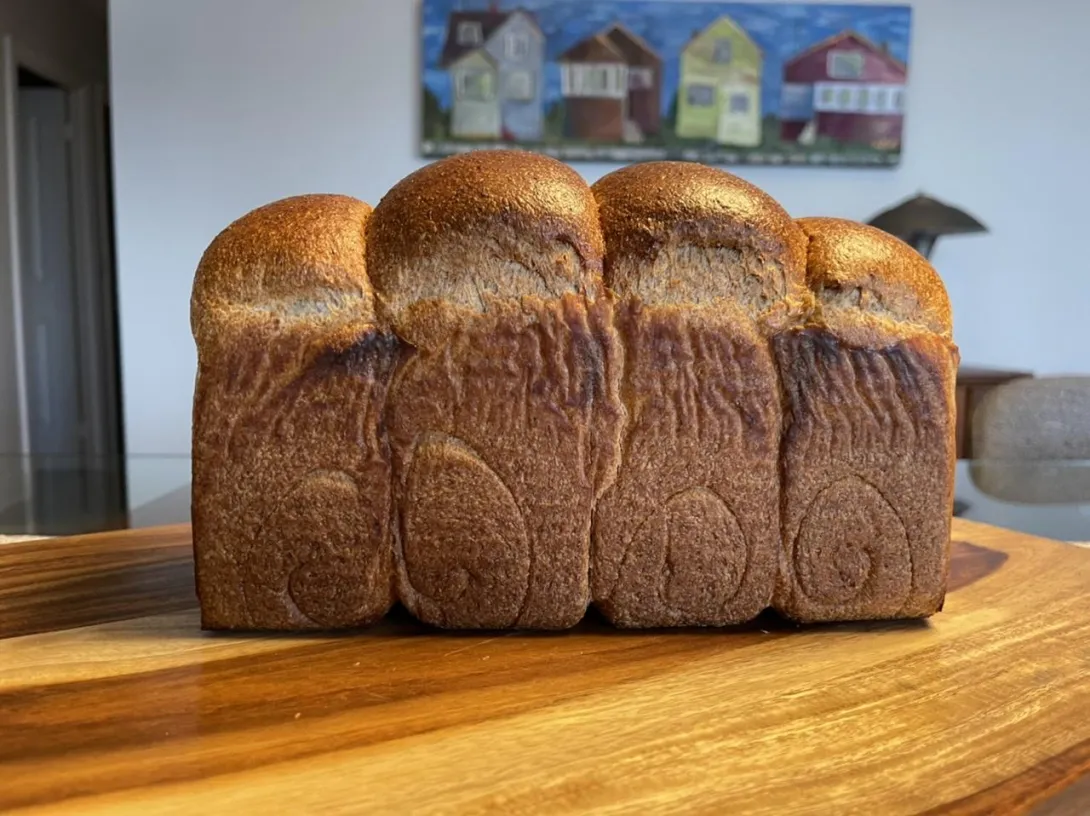
Back from two weeks off without any baking. My starter was refreshed two weeks ago at 50% hydration, given 1 hour at room temperature then refrigerated. The pH had only dropped to 4.4 or so when I returned so there was plenty of food left. I discarded some, then brought the hydration up to 100% and did a small feed. He tripled in 3 hours but had not yet peaked, so I discarded and fed him again. 5 hours later he had peaked at 3.5-4x with the dome just starting to flatten. He was ready to build a levain for this bake.
You may have noticed my gradually increasing the whole wheat in my Hokkaido sourdough milk breads lately. I finally decided it was time to do 100% whole wheat and this didn’t disappoint.
For a 9” x 4” x 4” pullman pan
Sweet Stiff Starter
• 53g stoneground unsifted organic whole wheat flour
• 24g water
• 18g light brown sugar
• 18g sourdough starter ~100% hydration
1:1.33:2.9:1 starter:water:flour:sugar
Tangzhong classic 1:5 ratio
• 89g milk (adjusted down to 1:5 ratio from original)
• 18g stoneground unsifted organic whole wheat flour
Dough Dry Ingredients
• 9 g vital wheat gluten
· 424 g stoneground unsifted organic whole wheat flour
• 54g sugar 12.5%
• 7g salt 1.6%
Dough Wet Ingredients
• 180g milk (consider adding more milk 5 g next time, dough was stiff)
• 50g egg beaten (about 1 lg egg)
• 60g butter 13.9% softened but do not melt, unless you are mixing with the mixer then melt. Combine with 30 g of flour to make easier to add to dough if hand mixing.
Total flour = 513 g
Total weight 1004 g
Pre-bake Wash
• 1 egg beaten
• 1 Tbsp milk
Post-bake Wash
• 1 Tbsp butter
Instructions
Starter
Mix the starter ingredients in a jar or pyrex container with space for at least 50% growth. In fact I usually get 2.5-3.5x growth.
Press down with your knuckles to create a uniform surface and to push out air.
At room temperature, it typically takes up to 10 hours for this sweet stiff levain to be at peak.
Tangzhong
In a sauce pan set on med-low heat, whisk the milk and flour until blended. Then cook for several minutes until thickened, stirring regularly with a spoon or heat-resistant spatula. Let cool in the pan or, for faster results, in a new bowl.
Dough
In the bowl of a stand mixer, briefly whisk the dry dough ingredients, and then add the sweet stiff starter, separating it into 5-6 portions as you add it to the bowl.
Now pour/scrape in all the wet ingredients (including the tangzhong), with the melted butter last. With the dough hook attachment, mix on low speed for a minute, scrape down the sides, and then mix on medium speed for 15-20 minutes. The dough will seem very soft, but as you approach the 15-20 minute mark, it should not stick to your hands and should pass the windowpane test.
Transfer the dough to a lightly oiled bowl, form it into a ball, flip it smooth side up, cover and let rise for 6-12 hours depending on room temperature. You can place the dough into the fridge to chill the dough for about 1.5 hours, this makes rolling the dough easier.
Prepare your pans by greasing them or line with parchment paper.
Scrape the dough out onto a clean counter top. Lightly flour the bench. Press the dough into a rectangle and divide it into four. Shape each tightly into a boule, allow to rest 5 mins. Using a rolling pin roll each ball out and then letterfold. Turn 90* and using a rolling pin roll each out to at least 8”. Roll each into a tight roll with some tension. Arrange the rolls of dough inside your lined pan alternating the direction of the swirls. This should allow a greater rise during proof and in the oven.
Cover and let proof for 2-4 hours (more if you put the dough in the refrigerator). I proof until the top of the dough comes to within 1 cm of the top edge of the pan.
Preheat the oven to 350F and brush the dough with the egg-milk wash. Just prior to baking brush with the egg-milk wash again.
Bake the loaves for 50 minutes or until the internal temperature is at least 190F. Shield your loaf if it gets brown early in the baking process. After 50 mins remove the bread from the pan and bake a further 10 mins by placing the loaf directly in the oven on the rack with the oven turned down to 325ºF. You can brush the top of the loaf with butter if you wish at this point while the bread is still hot.
Wonderful flavour, there isn’t any real sour tang and certainly no bitterness that I had always thought was characteristic of 100% whole wheat breads like this that I ate as a child. I’m not sure that the Vital Wheat Gluten was necessary, but I wanted to ensure that I was able to get the shreddable crumb that this type of bread should have.
Benny
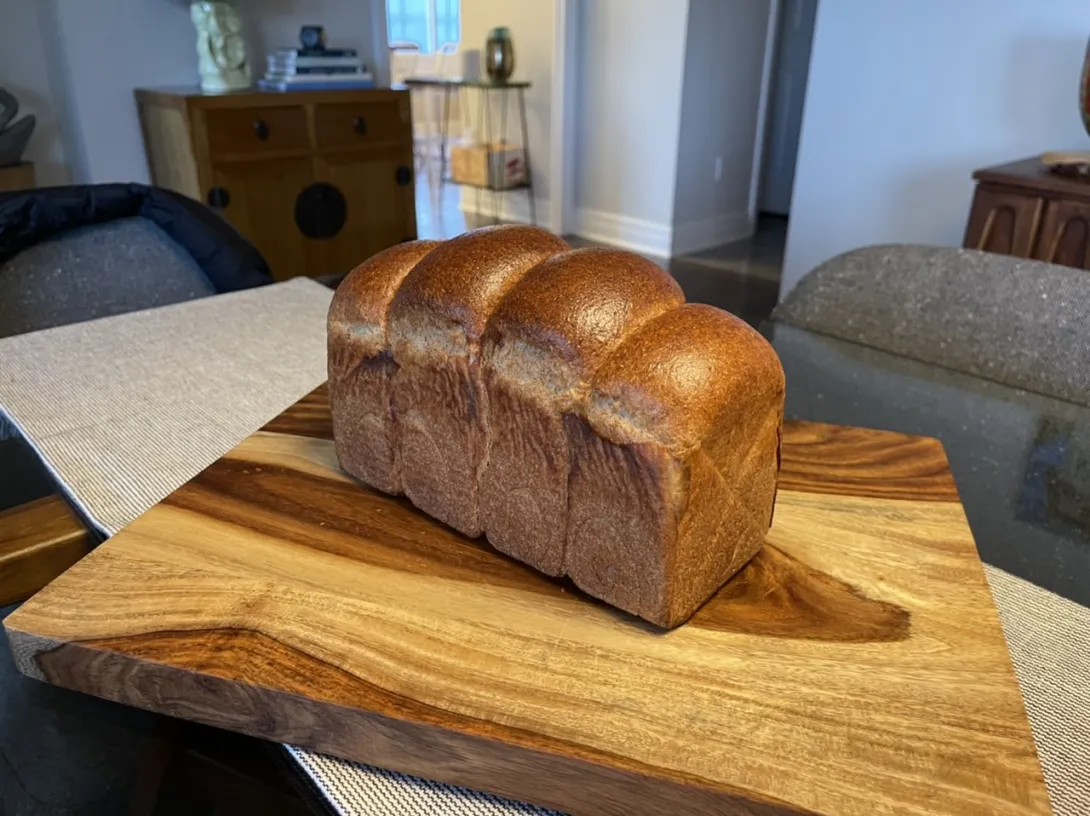
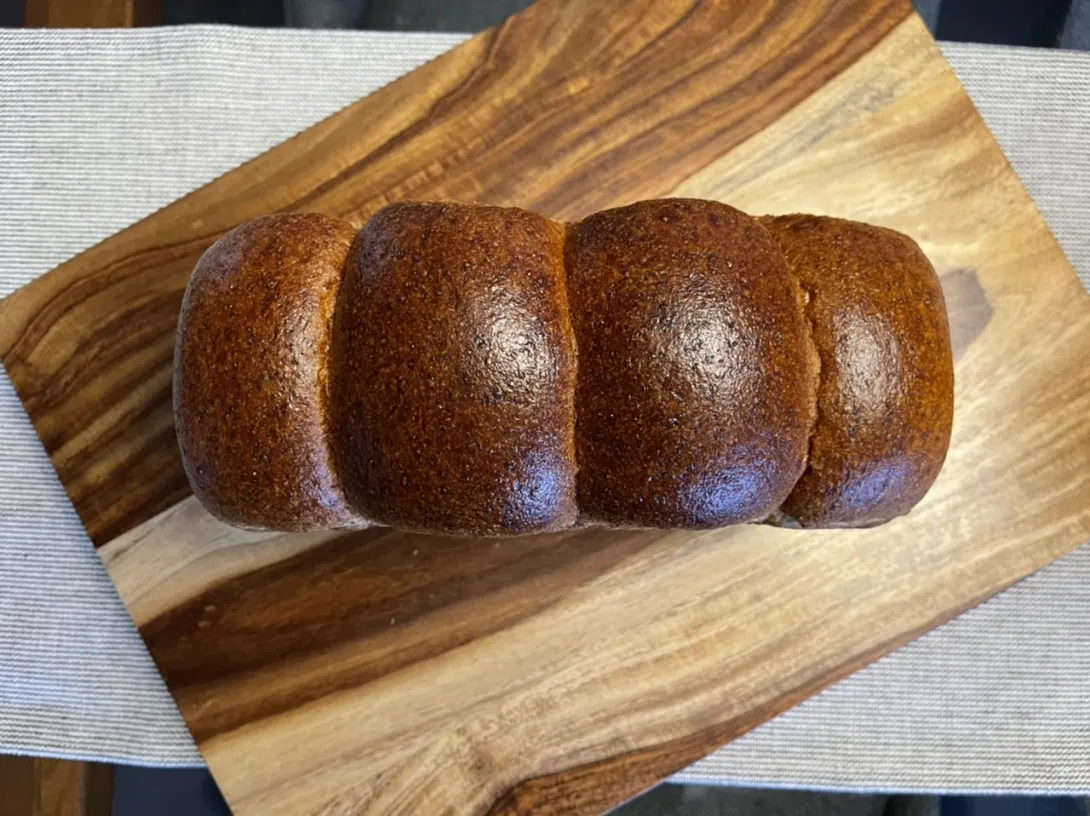
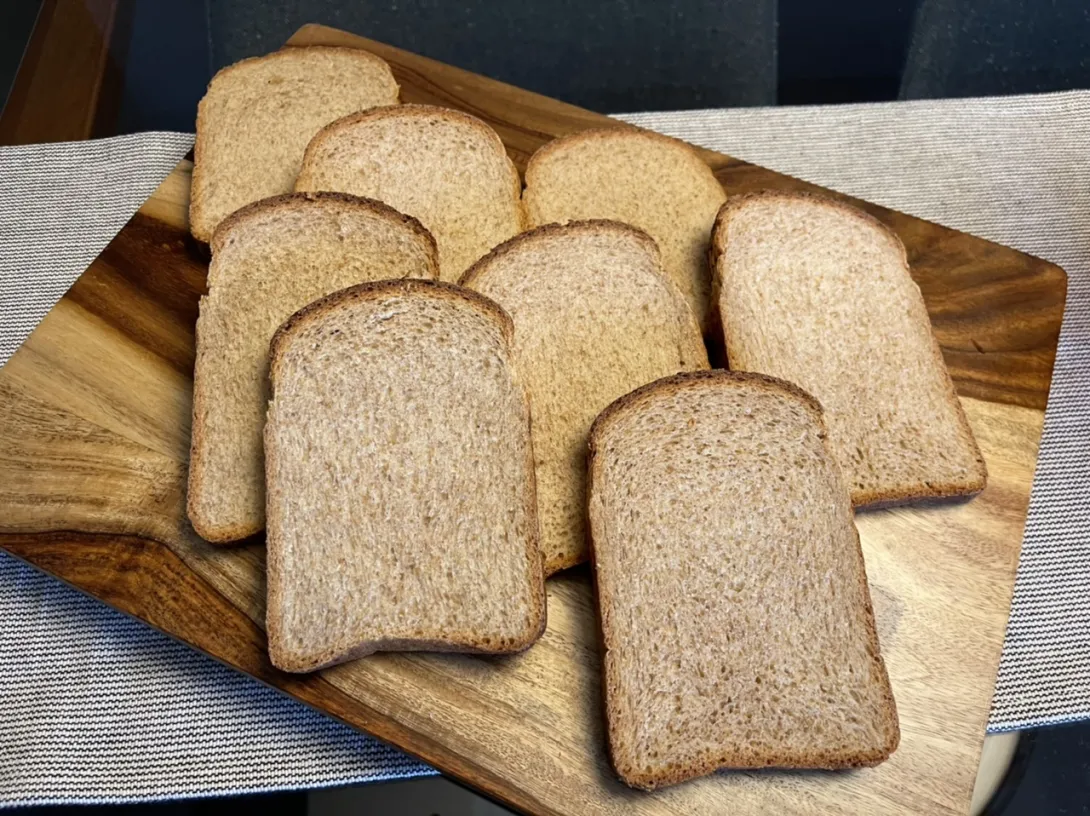
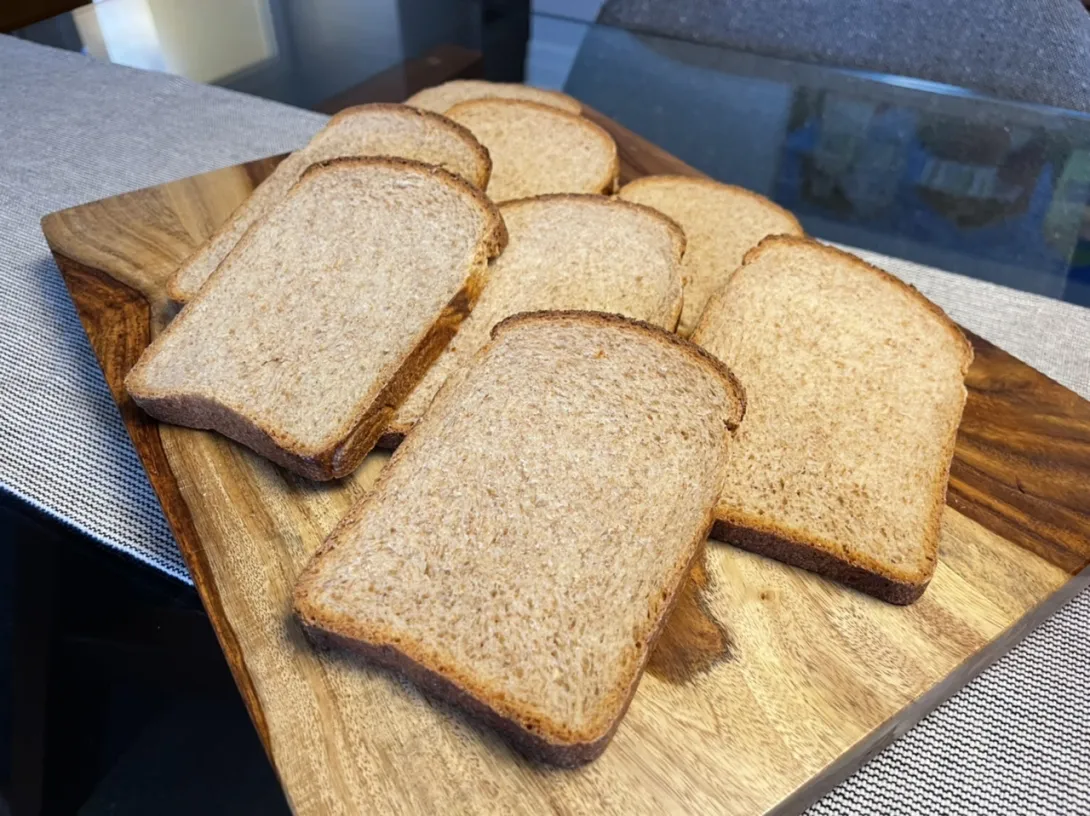
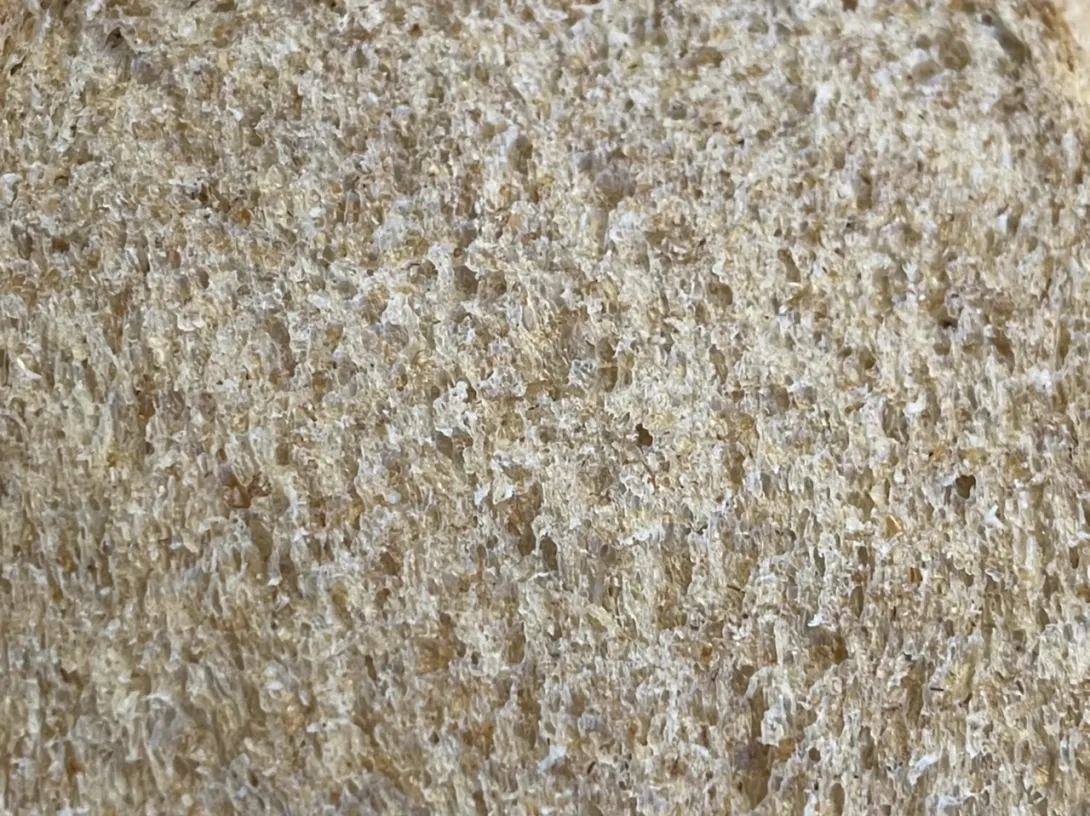
- Benito's Blog
- Log in or register to post comments
OK I understand better now what you mean by your white warm levain. You can use any flour for your levain that you wish, but of course then it won’t be 100% whole wheat. My starter is 100% rye so in fact my bread isn’t exactly 100% whole wheat, but the rye component is minuscule. Using your 80% hydration white levain will not control the LAB and will thus give your bread some sour tang that you may like but that isn’t characteristic of this style of bread. If you do try it I’d be interested in how it turns out. I would worry about the proteolytic effects of the acid in the bread.
Give the stiff sweet levain a try, if you like to make a levain that needs 12 hours to peak it is a good one. The low hydration and sugar really slows it down. As written the levain takes 10-12 hours to peak when fermented at 76°F.
Benny
Perfect, so my take aways from your comments are:
Did I get that right?
I finally wanted to ask you for a general recommendation. I am trying different whole grain recipes, especially those with little fat content to serve my family for breakfast. Do you have a go-to whole-grain loaf that you would recommend or that you absolutely love?
I think I was incomplete in a statement earlier about the higher less acidic nature of this dough, I forgot to state that the egg also contributes to the higher pH of the dough. However, the other statements you made are correct, so yes you got it right.
I have in my blog a couple of other 100% whole grain recipes I’ve recently had success with. There are a couple of whole wheat and a couple of spelt ones all without any added fat, so no oil or butter. Have a look at my blog, I also have an index of all the bakes I’ve posted that might make it easier for you to find a specific recipe. Benito’s Index of Bakes. In the most recent 100% spelt loaf I used a stiff sweet levain while in the 100% whole wheat ones I did not.
Benny
Excellent. I will try them out. Thanks so much for your help Benny!
Ha! When I saw the pic I thought, that looks like a Benny loaf! And i was right! Looks beautiful as usual
Thank you LL! Hope you’re surviving winter.
Benny
Yes, not too bad in BC. I heard about the Ontario snow storm!
We’ve been in Florida on vacation for the past week so although we were in Ontario for the storm earlier in January, the most recent one we were lucky enough to have missed.
Benny
Benny- I am finally getting around to re-making this whole wheat enriched bread and determined to improve the results. So I decided to see if creating an osmotolerant starter would assist in the fermentation. You may recall that I posted the method for this on a previous reply. So at this moment, I am waiting for the starter to fully ripen, but after 13.5 hours, the starter has only risen by about 50%. I may proceed with the dough making anyway, but I want to know your secret. I have had my 100% starter triple, but this stiff starter doesn’t look like it will ripen any further. Perhaps I should start again (probably next time) with a very active fresh 100% starter that I have fed a couple of times before creating the still sweet levain in your recipe.
So any suggestions would be appreciated! Thanks.
Caryn, I’m happy that you’re trying this again. What temperature are you fermenting your levain at, is it pretty warm or cool? For an overnight of 10-11 hours I will ferment at around 76-78°F so warmer than most people’s room temperature. I typically only feed my starter weekly. I allow it to peak and then it is refrigerated at 3-4°C. My starter is 100% rye and 100% hydration but that shouldn’t make a difference really, I know others who build stiff sweet levains and have no issue with AP starters.
It wouldn’t hurt to give your starter at least one feed prior to making the levain to get it really active and once at peak build your stiff sweet levain.
Benny
Benny- Thanks for your very quick response. I definitely will keep your hints in mind for the next time. I did ferment the sweet starter at 76°F for at least 11 hours. I am curious whether you keep your usual rye starter at 76 to 78°F when feeding it, because I generally keep my usual starters at 72°F.
As I suggested, I am continuing with bake even though the sweet levain for the recipe only rose about 50%. The worst (I hope) that will happen is I will get a result similar to last time which, though not as tall as yours, was still really delicious. This time I am going to have to retard the dough in the refrigerator after the bulk ferment since I don’t want to risk having to bake it late at night.
By the way, I noticed that you are from Canada (somewhere in Ontario, I think). I am half Canadian ; my mom was born and raised in Toronto. I wish somehow I could have acquired that citizenship! I have always loved your country and maybe more so now, given our politics!
Hi Caryn, yes I’m in Ontario, Toronto to be exact where your mother was from. It’s a great place to live, I love how multicultural the city is, our food scene is so exciting. Yes your politics in the US are very polarized at the moment and I hope that ours don’t become more like that, but whenever the US gets a sniffle we get a cold.
I tend to ferment my breads and starter at 82°F. My levains I adjust the temperature for when I want them to be ready for use.
If you are worried that this isn’t going to work you could spike your dough with a tiny pinch of IDY.
Benny- I baked my second loaf of this dough formula yesterday. The good news is that it tastes good and the crumb is nice too, but not as airy as yours and with a considerable tang. So, given the stubborn person that I am, I would like to figure out how I can duplicate your results for the next time. I have been busy feeding my 100% starter using AP and whole wheat to see how much I can get the liquid starter to rise before converting it to the stiff sweet starter in the recipe. You stated that you use rye flour for your liquid starter and think that it probably shouldn’t make a difference, but I may want to test that. Are you using whole grain rye or white rye? I have rye berries that I can grind for my starters if that is what you use.
Also, maybe you could clarify exactly what your steps are before making the sweet stiff starter. How much time generally has elapsed from the last feeding of the liquid starter to your making of the stiff one, and how much rise do you generally get from your liquid starter?
Thanks for all of your advice!
—Caryn
Hi Caryn. I use whole rye to feed my starter. There can be anywhere between 1-7 days from last feeding to building the levain. I usually get 3-3.5 x rise for my starter fermenting at 82°F. Despite the 100% hydration the whole rye starter is fairly stiff compared with the same hydration AP starter.
Honestly i don’t do much special for my starter since switching to whole rye, it is strong and I can make any levain without refreshing it up to 7 days after a feed.
So what ratios do you use to feed the rye starter and for how long does it take for the 3.5 rise?
Thx!
The feeds vary usually between 1:2:2 and 1:3:3 and typically I’ll see that peak between 5-6 hours @ 82°F.
Thank you!
Hi Benny- I have started to go down a rabbit hole of sourdoughs and maintenance. You inspired me to see if I can improve my starter, even though it has mostly served me well over the years. The fact that it was sluggish while making your whole wheat sandwich bread, just inspires me to see what I can do to improve it. Since your starter is reliably robust, I am wondering what type of schedule you use for it. Do you refrigerate it when it will be several days before baking and how often do you “refresh” it? The reason for the quotes around “refresh” is I think refreshing usually means discarding most of it and adding to a small percentage of it, rather than just adding to it.
The other issue I have, and perhaps that I need to scour this site or start a topic about for more feedback, is what is the best method to maintain a starter without so much waste? I recently borrowed Chad Robertson’s “bread book” and when explaining how to maintain a starter, he specifies using 30g of starter and 150g each of flour and water. So you are discarding 300g of starter every time that you refresh. That seems so wasteful and I assume unnecessary! What is your take on this?
I learned a method from Nathan Myhrvold in his “Modernist Bread” where you feed your starter 1:4:4 and immediately put it in ice cube tray(s) without allowing any fermentation. When you are ready to use it, you take out what you need for your bread (plus a bit more for your next feed) and allow it to ferment at room temperature for 18 hours. (You can also add glycerin at 2% of the flour weight, if you want to prolong its life in the freezer.) This has been working for me. Depending on the bread, it usually works really well, yielding nice crumb, good flavor and good oven-spring. However, it obviously does not have the rising power sufficient to proof the bread in your Fresh Loaf post.
—Caryn
I essentially have no discard if I plan well ahead and know how much starter I’ll need each week. I try to make only enough starter so that I have only 5 g of starter left after my weekly baking. I feed my starter only once per week generally speaking. So let’s say I expect to bake twice and will need 20 g of starter in total for those two bakes and I have my projected 5 g of starter. I will give it a 1:2:2 feed so 5 g of starter, 10 g of water and 10 g of whole rye. I like to keep a 100% hydration starter and only use whole rye to feed it. My experience has been that this keeps my starter robust and consistent. I will then ferment this at 82°F until it is at peak and then refrigerate it pulling it out of the fridge only to build levains during the 7 days after feeding. Regardless of how many days ago my starter was fed, I will use whatever amount I need without refreshing/feeding my starter as long as it was fed within the past 7 days. So that is what I do on an ongoing basis and it has worked for me for quite some time now.
To get to this point where I don’t give my starter much thought, I fed my starter 1:2:2 or 1:3:3 and kept it out at room temperature or warmer for several days until it was able to rise 3-4 x for at least a few feedings. At that point I felt it was healthy and active and then converted to my weekly feedings and refrigeration.
Benny- I love how this works for you. After I know that my starter has improved after using whole rye to develop it, I will try your method. I just need one clarification. Do the formulas that you are using only require 10 grams of starter? Or have you developed a method of creating an overnight elaboration before following the formula? I know Hamelman’s breads start with a bit more for roughly a 1k loaf.
Because I have so many of my formulas designed for an overnight levain build I typically only require 10-15 g of starter. If I’m a bit short I can just start the levain build earlier in the evening or ferment warmer or both.
Anyhow, you just have to guesstimate how much starter you need for your bakes. So if you need say 20 g of starter twice that week and you have 5 g of starter, then do a 1:4:4 build, 5 g starter, 20 g water and 20 g whole rye and you’ll have enough for your two levains. Or you could do smaller feeds and feed twice that week. So many ways to do this and have no discard. Instead of having discard, if I have a teaspoon of starter more than 5 g, I’ll dry it and add it to my back up in the freezer.
Benny- This makes sense. One more question- If you are feeding your starter 1:4:4, do you then allow more time for its ripening?
Yes higher ratio feeds will require more time for the starter or levain to reach peak. You can also ferment warmer or cooler to vary the time needed to reach peak.
Benny
Thank you!
This is a beautiful bread! I would love to give it a try - thanks for sharing your formula! Quick question...what is the benefit of using a sweet starter? I've never tried this and am intrigued...
Thank you very much. I hope you do give this a try.
The following is the explanation I posted on IG when I made the stiff sweet levain for a Hokkaido milk bread bake.
“Stiff sweet levain. This is the style of levain I build when I wish to bake sourdough bread without the sour tang. I particularly like this for enriched breads such as this Hokkaido milk bread which has butter, sugar and a tangzhong with milk. So why does this work to reduce the sour tang? We know that low hydration is more challenging for the microbes and more so for the LAB which make most of the acids. Then the osmotic pressure exerted on the microbes by the presence of sugar has a dehydrating effect on the microbes and again more so on the LAB than yeast. So both the low hydration and the sugar causes the LAB portion of the microbes to be reduced as this levain ferments. You can see this through the pH change as the levain ferments to peak. This levain started at pH 5.29 and at peak with 3.5-4 times rise had a pH of 5.22. If this was a levain of 100% hydration but without sugar I would expect the pH to drop about 1.3 at peak so you can see how little acid was produced in this levain. Now more importantly the dough this levain will make will also have less LAB than usual and the pH won’t fall to the same degree as you would usually expect. Besides a smaller pH fall you can definitely taste this difference with a bread lacking sour tang.”
Never knew there was so much to know about sourdough...
I'm going to make this, even if it is a lot of trouble. Been looking for a way to enjoy whole-grain bread. Will try it with Khorasan flour (or the trademarked version called Kamut which is guaranteed not to be crossed with modern wheat). Wonderful warm bright sweet flavor, Khorasan has. Might be able to reduce the sugar in this recipe. My impression is that the bitterness you (and I) associate with whole-grain wheat bread is due to the age of the flour. Now that I'm grinding my own, I don't detect any bitterness -- but standard modern wheat is still duller tasting than Khorasan.
I love the flavour and colour of Kamut Joanna, I agree about its sweet almost buttery flavour. I’ve done this bread with Kamut and loved it. Yes the at least some of the bitterness of whole grains is associated with less fresh flour. Now that I am able to get much fresher flours I haven’t had bitter whole grain breads. Milling obviously would be even better. I hope you post your bake of this bread, I’d love to see it.
Benny